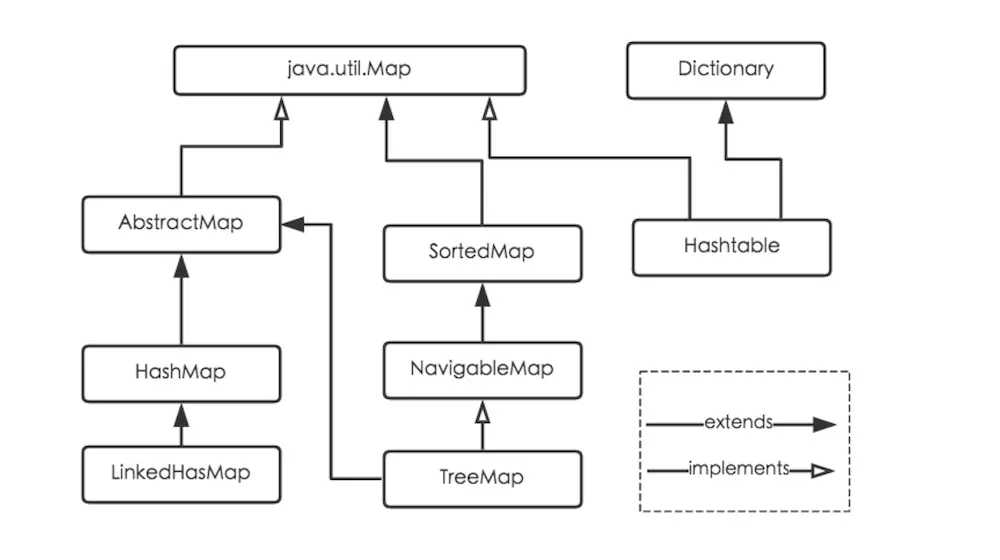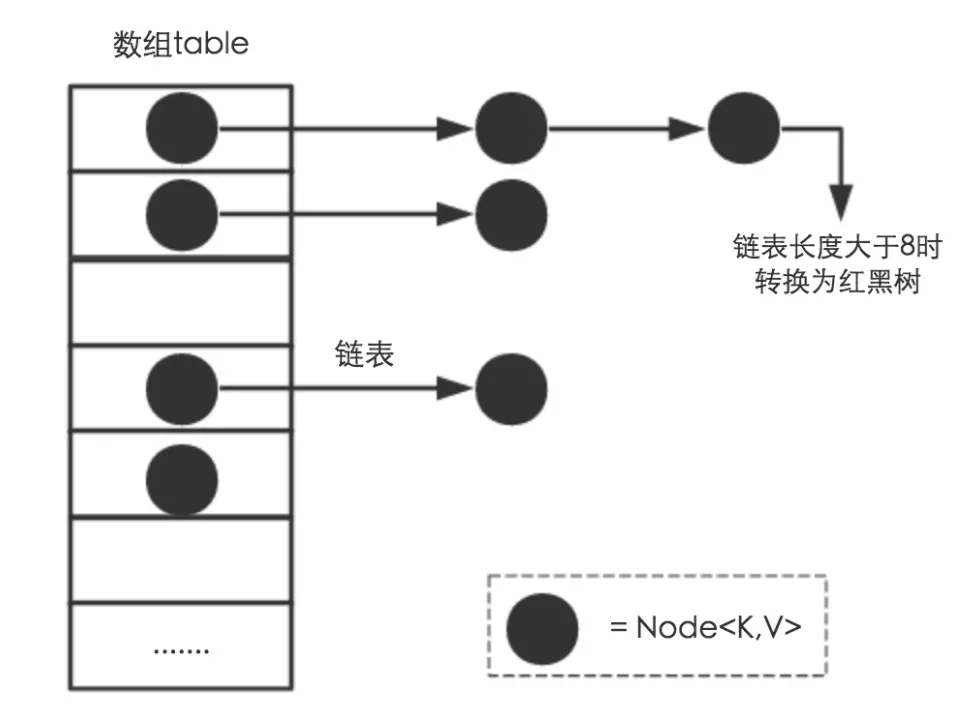MAP 类继承图
HashMap:
KV结构,高效
无序
key为null,但是只允许有一个key为null,再次说明,
HashMap不是线程安全的。
LinkedHashMap: LinkedHashMap是HashMap的子类,它将保持记录的插入顺序。
TreeMap: TreeMap实现了SortedMap接口,很明显,他将对插入的记录排序,
HashMap 内部结构 首先来看一下HashMap内部结构是什么样子的。通过观察源码,可以发现HashMap在实现上使用了数组+链表+红黑树三种数据结构
HashMap是通过计算key的hashCode来找到记录的存储位置的,那因为hash函数不会台完美的原因,势必要造成多个记录的key的hashCode一样的情况,上图展示了这种情况,完美情况下,我们希望每一个数组位置上仅有一个记录,但是很多情况下一个数组位置上会落入多个记录,也就是哈希冲突。
1 2 3 4 5 6 7 8 9 10 11 12 13 14 15 16 17 18 19 20 21 22 23 24 25 26 27 28 29 30 31 32 33 34 35 36 37 38 39 static class Node <K ,V > implements Map .Entry <K ,V > final int hash; final K key; V value; Node<K,V> next; Node(int hash, K key, V value, Node<K,V> next) { this .hash = hash; this .key = key; this .value = value; this .next = next; } public final K getKey () return key; } public final V getValue () return value; } public final String toString () return key + "=" + value; } public final int hashCode () return Objects.hashCode(key) ^ Objects.hashCode(value); } public final V setValue (V newValue) V oldValue = value; value = newValue; return oldValue; } public final boolean equals (Object o) if (o == this ) return true ; if (o instanceof Map.Entry) { Map.Entry<?,?> e = (Map.Entry<?,?>)o; if (Objects.equals(key, e.getKey()) && Objects.equals(value, e.getValue())) return true ; } return false ; } }
下面是上面图中展示的数组:
1 transient Node<K,V>[] table;
这个table就是存储数据的数组,上面图中的每个黑色的球是一个Node。下面展示了几个重要的成员变量:
1 2 3 4 5 6 7 8 9 10 11 12 13 14 15 16 17 18 19 20 21 22 23 24 25 26 27 28 29 30 31 32 33 34 35 36 37 38 39 transient int size; int threshold; final float loadFactor; static final int DEFAULT_INITIAL_CAPACITY = 1 << 4 ; static final int MAXIMUM_CAPACITY = 1 << 30 ; static final float DEFAULT_LOAD_FACTOR = 0.75f ;
需要注意的一点是,HashMap的哈希桶table的大小必须为2的n次方,也就是说必须为合数,初始大小为16,下文中将会说明为什么一定要是2的n次方。size字段的意思是当前记录数量,loadFactor是负载因子,默认为0.75,而threshold是作为扩容的阈值而存在的,它是由负载银子决定的。下面的方法是返回与给定数值最接近的2的n次方的值:
1 2 3 4 5 6 7 8 9 10 11 12 static final int tableSizeFor (int cap) int n = cap - 1 ; n |= n >>> 1 ; n |= n >>> 2 ; n |= n >>> 4 ; n |= n >>> 8 ; n |= n >>> 16 ; return (n < 0 ) ? 1 : (n >= MAXIMUM_CAPACITY) ? MAXIMUM_CAPACITY : n + 1 ; }
HashMap如何确定记录的table位置 下面的方法hash展示了HashMap是如何计算记录的hashCode值的方法:
1 2 3 4 static final int hash (Object key) int h; return (key == null ) ? 0 : (h = key.hashCode()) ^ (h >>> 16 ); }
上面的hash方法仅仅是第一步,它只是计算出了hashCode值,但是还可以确定table中的index,接下来的一步需要做的就是根据hashCode来定位index,也就是需要对hashCode取模(hashCode % length),length是table的长度,但是我们知道,取模运算是较为复杂的计算,是非常耗时的计算,那有没有方法不通过取模计算而达到取模的效果呢,答案是肯定的,上文中提到,table的长度必然是2的n次方,这点很重要,HashMap通过设定table的长度为2的n次方,在取模的时候就可以通过下面的算法来进行:
1 int index = hashCode & (length -1 )
在length总是2的n次方的前提下,上面的算法等效于hashCode%length,但是现在通过使用&代替了%,而&的效率要远比%高
HashMap插入元素的过程详解 1 2 3 4 5 6 7 8 9 10 11 12 13 14 15 16 17 18 19 20 21 22 23 24 25 26 27 28 29 30 31 32 33 34 35 36 37 38 39 40 41 42 43 44 45 46 public V put (K key, V value) return putVal(hash(key), key, value, false , true ); } final V putVal (int hash, K key, V value, boolean onlyIfAbsent, boolean evict) Node<K,V>[] tab; Node<K,V> p; int n, i; if ((tab = table) == null || (n = tab.length) == 0 ) n = (tab = resize()).length; if ((p = tab[i = (n - 1 ) & hash]) == null ) tab[i] = newNode(hash, key, value, null ); else { Node<K,V> e; K k; if (p.hash == hash && ((k = p.key) == key || (key != null && key.equals(k)))) e = p; else if (p instanceof TreeNode) e = ((TreeNode<K,V>)p).putTreeVal(this , tab, hash, key, value); else { for (int binCount = 0 ; ; ++binCount) { if ((e = p.next) == null ) { p.next = newNode(hash, key, value, null ); if (binCount >= TREEIFY_THRESHOLD - 1 ) treeifyBin(tab, hash); break ; } if (e.hash == hash && ((k = e.key) == key || (key != null && key.equals(k)))) break ; p = e; } } if (e != null ) { V oldValue = e.value; if (!onlyIfAbsent || oldValue == null ) e.value = value; afterNodeAccess(e); return oldValue; } } ++modCount; if (++size > threshold) resize(); afterNodeInsertion(evict); return null ; }
过程的详细分析
首先判断table是否为null或者长度为0,如果是,那么调用方法resize来初始化table,resize的细节将在下文中进行分析,这个方法用来对HashMap的table数组扩容,它将发生在初始化table以及table中的记录数量达到阈值之后。
然后计算记录的hashCode,以及根据上文中提到的方法来计算记录在table中的index,如果发现index未知上为null,则调用newNode来创建一个新的链表节点,然后放在table的index位置上,此时表面没有哈希冲突。
如果table的index位置不为空,那么说明造成了哈希冲突,这时候如果记录和index位置上的记录相等,则直接覆盖,否则继续判断
如果index位置上的节点TreeNode,如果是,那么说明此时的index位置上是一颗红黑树,需要调用putTreeVal方法来将这新的记录插入到红黑树中去。否则走下面的逻辑。
如果index位置上的节点类型不是TreeNode,那么说明此位置上的哈希冲突还没有达到阈值,还是一个链表结构,那么就根据插入链表插入新节点的算法来找到合适的位置插入,这里面需要注意的是,新插入的记录会覆盖老的记录,如果这个新的记录是首次插入,那么就会插入到该index位置上链表的最尾部,这里面还需要一次判断,如果插入了新的节点之后达到了阈值,那么就需要调用方法+treeifyBin来讲链表转化为红黑树。
在插入完成之后,哈希桶中记录的数量是否达到了哈希桶设置的阈值,如果达到了,那么就需要调用方法resize来扩容。
HashMap扩容resize方法详解 上文分析了HashMap的put方法的细节,其中提到,当初始化table以及记录数量达到阈值之时会触发HashMap的扩容,而扩容是通过方法resize来进行的,下面来分析一下resize方法是如何工作的。
1 2 3 4 5 6 7 8 9 10 11 12 13 14 15 16 17 18 19 20 21 22 23 24 25 26 27 28 29 30 31 32 33 34 35 36 37 38 39 40 41 42 43 44 45 46 47 48 49 50 51 52 53 54 55 56 57 58 59 60 61 62 63 64 65 66 67 68 69 70 71 72 73 final Node<K,V>[] resize() { Node<K,V>[] oldTab = table; int oldCap = (oldTab == null ) ? 0 : oldTab.length; int oldThr = threshold; int newCap, newThr = 0 ; if (oldCap > 0 ) { if (oldCap >= MAXIMUM_CAPACITY) { threshold = Integer.MAX_VALUE; return oldTab; } else if ((newCap = oldCap << 1 ) < MAXIMUM_CAPACITY && oldCap >= DEFAULT_INITIAL_CAPACITY) newThr = oldThr << 1 ; } else if (oldThr > 0 ) newCap = oldThr; else { newCap = DEFAULT_INITIAL_CAPACITY; newThr = (int )(DEFAULT_LOAD_FACTOR * DEFAULT_INITIAL_CAPACITY); } if (newThr == 0 ) { float ft = (float )newCap * loadFactor; newThr = (newCap < MAXIMUM_CAPACITY && ft < (float )MAXIMUM_CAPACITY ? (int )ft : Integer.MAX_VALUE); } threshold = newThr; @SuppressWarnings ({"rawtypes" ,"unchecked" }) Node<K,V>[] newTab = (Node<K,V>[])new Node[newCap]; table = newTab; if (oldTab != null ) { for (int j = 0 ; j < oldCap; ++j) { Node<K,V> e; if ((e = oldTab[j]) != null ) { oldTab[j] = null ; if (e.next == null ) newTab[e.hash & (newCap - 1 )] = e; else if (e instanceof TreeNode) ((TreeNode<K,V>)e).split(this , newTab, j, oldCap); else { Node<K,V> loHead = null , loTail = null ; Node<K,V> hiHead = null , hiTail = null ; Node<K,V> next; do { next = e.next; if ((e.hash & oldCap) == 0 ) { if (loTail == null ) loHead = e; else loTail.next = e; loTail = e; } else { if (hiTail == null ) hiHead = e; else hiTail.next = e; hiTail = e; } } while ((e = next) != null ); if (loTail != null ) { loTail.next = null ; newTab[j] = loHead; } if (hiTail != null ) { hiTail.next = null ; newTab[j + oldCap] = hiHead; } } } } } return newTab; }
上面展示了resize方法的细节,可以看到扩容的实现时较为复杂的,但是我们知道所谓扩容,就是新申请一个较大容量的数组table,然后将原来的table中的内容都重新计算哈希落到新的数组table中来,然后将老的table释放掉。这里面有两个关键点,一个是新哈希数组的申请以及老哈希数组的释放,另外一个是重新计算记录的哈希值以将其插入到新的table中去。首先第一个问题是,扩容会扩大到多少,通过观察上面的代码可以确定,每次扩容都会扩大table的容量为原来的两倍,当然有一个最大值,如果HashMap的容量已经达到最大值了,那么就不会再进行扩容操作了。第二个问题是HashMap是如何在扩容之后将记录从老的table迁移到新的table中来的。上文中已经提到,table的长度确保是2的n次方,那么有意思的是,每次扩容容量变为原来的两倍,那么一个记录在新table中的位置要么就和原来一样,要么就需要迁移到(oldCap + index)的位置上。下面简单来证明一下这个算法的正确性:
1 2 3 4 假设原来的table大小为4,那么扩容之后会变为8,那么对于一个元素A来说,如果他的hashCode值为3,那么他在原来的table 上的位置为(3 & 3) = 3,那么新位置呢?(3 & 7) = 3,这种情况下元素A的index和原来的index是一致的不用变。再来看一个 元素B,他的hashCode值为47,那么在原来table中的位置为(47 & 3) = 3,在新table中的位置为(47 & 7) = 7,也就 是(3 + 4),正好偏移了oldCap个单位。
之所以可以这么算是因为3和47,在table长度为4的情况下,因为3 二进制为 11,所以A和B会有两位参与运算来
在table的length为4的前提下:
1 2 3-> 11 & 11 = 3 47-> 000011 & 101111 = 3
在扩容后,length变为8:
1 2 3-> 011 & 111 = 3 47-> 10111 & 00111 = 7
对于3来说,新增的参与运算的位为0,所以index不变,而对于47来说,新增的参与运算的位为1,所以index需要变为(index + oldCap)
HashMap获取记录操作详解 首先,因为可能会发生哈希冲突,所以我们需要获取的记录可能会存储在一个链表上,也可能存储在一棵红黑树上,这需要实际判断,所以,获取操作首先应该就算记录的hashCode,然后根据hashCode来计算在table中的index,然后判断该数组位置上是一条链表还是一棵红黑树,如果是链表,那么就遍历链表来找到我们需要的记录,否则如果是一棵红黑树,那么就通过遍历这棵红黑树找到我们需要的记录.
当然,寻找记录可能会找不到,因为可能我们获取的记录根本就不存在,那么就要返回null暗示用户,当然,HashMap返回null不仅可以代表没有这个记录的信息之外,还可以代表该记录key对应着的value就是null,所以你不能通过HashMap是否返回null来判断HashMap中是否有相应的记录,如果你有类似的需求,你应该调用HashMap的方法:containsKey,这个方法将在下文中进行分析。
1 2 3 4 5 6 7 8 9 10 11 12 13 14 15 16 17 18 19 20 21 22 23 24 public V get (Object key) Node<K,V> e; return (e = getNode(hash(key), key)) == null ? null : e.value; } final Node<K,V> getNode (int hash, Object key) Node<K,V>[] tab; Node<K,V> first, e; int n; K k; if ((tab = table) != null && (n = tab.length) > 0 && (first = tab[(n - 1 ) & hash]) != null ) { if (first.hash == hash && ((k = first.key) == key || (key != null && key.equals(k)))) return first; if ((e = first.next) != null ) { if (first instanceof TreeNode) return ((TreeNode<K,V>)first).getTreeNode(hash, key); do { if (e.hash == hash && ((k = e.key) == key || (key != null && key.equals(k)))) return e; } while ((e = e.next) != null ); } } return null ; }
首先会获得当前table的一个快照,然后根据需要查找的记录的key的hashCode来定位到table中的index,如果该位置为null,说明没有没有记录落到该位置上,也就不存在我们查找的记录,直接返回null。如果该位置不为null,说明至少有一个记录落到该位置上来,那么就判断该位置的第一个记录是否使我们查找的记录,如果是则直接返回,否则,根据该index上是一条链表还是一棵红黑树来分别查找我们需要的记录,找到则返回记录,否则返回null。下面来看一下如何判断HashMap中是否有一个记录的方法:
1 2 3 public boolean containsKey (Object key) return getNode(hash(key), key) != null ; }
这个方法调用了getNode来从table中获得一个Node,返回null,说明不存在该记录,否则存在,containsKey方法和get方法都是通过调用getNode方法来进行的,但是他们的区别在于get方法在判断得到的Node不为null的情况下任然可能返回null,因为Node的value可能为null,所以应该在合适的时候调用合适的方法。
HashMap删除记录详解 现在来看一下HashMap是如何实现删除一个记录的。下面首先展示了相关的代码:
1 2 3 4 5 6 7 8 9 10 11 12 13 14 15 16 17 18 19 20 21 22 23 24 25 26 27 28 29 30 31 32 33 34 35 36 37 38 39 40 41 42 43 44 45 46 public V remove (Object key) Node<K,V> e; return (e = removeNode(hash(key), key, null , false , true )) == null ? null : e.value; } final Node<K,V> removeNode (int hash, Object key, Object value, boolean matchValue, boolean movable) Node<K,V>[] tab; Node<K,V> p; int n, index; if ((tab = table) != null && (n = tab.length) > 0 && (p = tab[index = (n - 1 ) & hash]) != null ) { Node<K,V> node = null , e; K k; V v; if (p.hash == hash && ((k = p.key) == key || (key != null && key.equals(k)))) node = p; else if ((e = p.next) != null ) { if (p instanceof TreeNode) node = ((TreeNode<K,V>)p).getTreeNode(hash, key); else { do { if (e.hash == hash && ((k = e.key) == key || (key != null && key.equals(k)))) { node = e; break ; } p = e; } while ((e = e.next) != null ); } } if (node != null && (!matchValue || (v = node.value) == value || (value != null && value.equals(v)))) { if (node instanceof TreeNode) ((TreeNode<K,V>)node).removeTreeNode(this , tab, movable); else if (node == p) tab[index] = node.next; else p.next = node.next; ++modCount; --size; afterNodeRemoval(node); return node; } } return null ; }
首先,通过记录的hashCode来找到他在table中的index,因为最后需要返回被删除节点的值,所以需要记录被删除的节点。当然记录被删除的节点也是有意义的,比如对于table中的index位置上为一条链表的情况来说,我们只需要记住需要删除的Node,然后真正删除的时候就可以只需要操作该node就可以了,当然对于链表的相关操作详解将在另外的篇章中进行。以及红黑树等高级数据结构的分析总结也会在新的篇章中介绍,目前只需要知道HashMap通过在合适的时候使用不同的数据结构来达到高效的目的就可以了。

